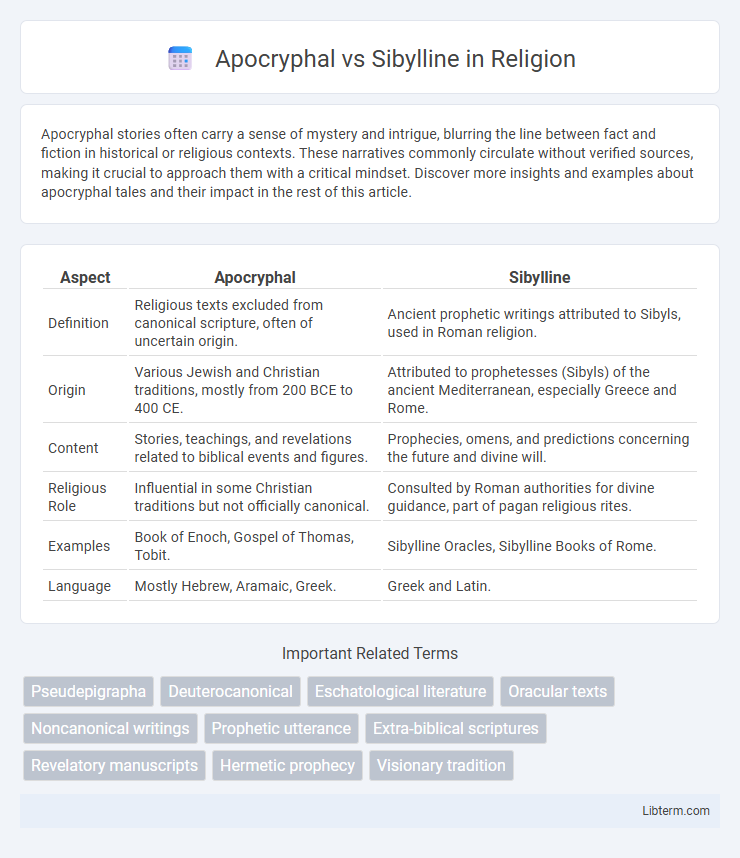Apocryphal stories often carry a sense of mystery and intrigue, blurring the line between fact and fiction in historical or religious contexts. These narratives commonly circulate without verified sources, making it crucial to approach them with a critical mindset. Discover more insights and examples about apocryphal tales and their impact in the rest of this article.
Table of Comparison
| Aspect | Apocryphal | Sibylline |
|---|---|---|
| Definition | Religious texts excluded from canonical scripture, often of uncertain origin. | Ancient prophetic writings attributed to Sibyls, used in Roman religion. |
| Origin | Various Jewish and Christian traditions, mostly from 200 BCE to 400 CE. | Attributed to prophetesses (Sibyls) of the ancient Mediterranean, especially Greece and Rome. |
| Content | Stories, teachings, and revelations related to biblical events and figures. | Prophecies, omens, and predictions concerning the future and divine will. |
| Religious Role | Influential in some Christian traditions but not officially canonical. | Consulted by Roman authorities for divine guidance, part of pagan religious rites. |
| Examples | Book of Enoch, Gospel of Thomas, Tobit. | Sibylline Oracles, Sibylline Books of Rome. |
| Language | Mostly Hebrew, Aramaic, Greek. | Greek and Latin. |
Introduction to Apocryphal and Sibylline Texts
Apocryphal texts consist of early Christian writings not included in the canonical Bible, often offering alternative perspectives on biblical events and figures. Sibylline texts refer to prophetic writings attributed to the Sibyls, ancient prophetesses whose oracles influenced Greco-Roman literature and religious thought. Both sets of texts provide valuable insight into religious beliefs and cultural contexts outside the established scriptural traditions.
Defining Apocryphal Writings
Apocryphal writings refer to texts of uncertain authenticity or those not included in the canonical Bible, often composed between the 3rd century BC and the 4th century AD. These texts, such as the Gospel of Thomas and the Book of Enoch, provide alternative narratives and theological insights outside mainstream Scripture. Unlike the Sibylline Oracles--prophetic poems attributed to Sibyls--apocryphal writings primarily encompass religious works with disputed origin or authority.
Understanding the Sibylline Oracles
The Sibylline Oracles are a collection of ancient prophetic texts written in Greek hexameter, attributed to various Sibyls, who were legendary prophetesses in antiquity. These oracles blend Jewish, Christian, and pagan elements, distinguishing them from the Apocryphal books, which primarily consist of non-canonical Jewish and early Christian writings. Understanding the Sibylline Oracles involves analyzing their role in shaping religious syncretism and their influence on early Christian eschatology and apocalyptic literature.
Historical Origins and Context
Apocryphal texts emerged primarily between the 2nd century BCE and 4th century CE, often as non-canonical writings related to biblical narratives with ambiguous authorship and uncertain authenticity. Sibylline texts trace their origins to the ancient Mediterranean world, notably in Greece and Rome, where Sibylline prophecies were collected and consulted from the 6th century BCE onwards as oracular writings believed to predict future events. Both Apocryphal and Sibylline writings served distinct religious and cultural purposes, reflecting divergent traditions of prophecy, authority, and textual preservation in antiquity.
Differences in Authorship and Attribution
Apocryphal texts are often attributed to biblical figures but lack canonical acceptance, whereas Sibylline texts are prophetic writings linked to the Sibyls, ancient oracles with a more mythical authorship. Apocryphal books typically emerge from Jewish or Christian traditions, authored by unknown or pseudonymous writers, while Sibylline oracles are composed by various Hellenistic or early Christian authors claiming divine inspiration. The key difference lies in Apocryphal works' religious and historical framing versus Sibylline texts' prophetic and oracular nature, reflecting distinct origins and purposes.
Theological Significance and Interpretation
Apocryphal texts, often excluded from canonical scripture, provide alternative theological perspectives and elaborate on biblical narratives, influencing early Christian beliefs and doctrinal debates. Sibylline writings, rooted in ancient prophetic traditions, offer eschatological insights and reflect the syncretism between Greco-Roman paganism and Judeo-Christian thought. Their theological significance lies in how they shaped religious interpretation, liturgical practices, and the development of apocalyptic literature within different faith communities.
Canonical Status and Religious Authority
Apocryphal texts lack official recognition within canonical scripture and are often viewed as non-authoritative by mainstream religious traditions, while Sibylline oracles, though sometimes integrated into liturgical contexts, generally occupy a marginal status without full canonical endorsement. The canonical status of Apocryphal writings varies across denominations, with some traditions considering them valuable for historical or theological insights yet not divinely inspired scripture. Sibylline prophecies, often prophetic or poetic in nature, exert symbolic religious authority but are primarily regarded as supplemental rather than foundational to official doctrine.
Literary Styles and Structures
Apocryphal texts typically exhibit diverse narrative styles, blending folklore, theological discourse, and allegory with complex, non-linear structures that emphasize mystical content and doctrinal themes. Sibylline texts, by contrast, often follow a prophetic and poetic form characterized by oracular pronouncements, rhythmic prose or verse, and structured declarations designed for liturgical or ritualistic use. The distinct literary styles reflect their differing purposes: Apocryphal writings aim to expand canonical narratives through elaborate storytelling, while Sibylline texts prioritize concise, authoritative prophecy embedded in ritual contexts.
Influence on Later Religious Traditions
Apocryphal texts significantly influenced later Christian traditions by expanding canonical narratives and shaping theological interpretations, often introducing alternative accounts of biblical events. Sibylline Oracles, blending Greco-Roman prophecy with Jewish and Christian themes, impacted early Christian eschatology and medieval prophetic literature. Both collections contributed to the development of religious symbolism and mystical thought across subsequent spiritual movements.
Modern Scholarship and Debates
Modern scholarship differentiates Apocryphal texts as non-canonical writings often linked to early Christian or Jewish traditions, whereas Sibylline literature originates from ancient prophetic collections attributed to Sibyls, female seers of classical antiquity. Debates concentrate on the historical authenticity and theological significance of these texts, with scholars analyzing linguistic styles, manuscript transmission, and their influence on religious thought. The growing field of textual criticism employs interdisciplinary methods, including philology and comparative mythology, to reassess the boundaries between apocryphal and Sibylline works.
Apocryphal Infographic

 libterm.com
libterm.com